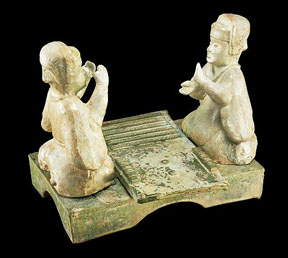
Eastern Han dynasty
1st-2nd century CE
Earthenware, green lead glaze
H: 25.6 cm (max)
Gift of The British Museum Friends
Acquisition number: #OA 1933.11-14.1
Image courtesy of the British Museum (copyright reserved)
Small earthenware burial statues and figurines have survived in great numbers from the Han era. Some are made of undecorated clay, while others may be painted with a clay slip, as seen in the example from the Seattle Art Museum. More unusual are tomb figurines covered in a green lead glaze, such as we find decorating this example. Lead glaze was not only more expensive, it was also more difficult to control in the kiln, and for these reasons lead-glazed wares and figures are believed to have carried more prestige value than unglazed pottery or slip wares.
We might wonder why sculptures intended for interment in a Han tomb would depict such a pedestrian subject as two gentlemen passing the time in a game of chance. Such tomb figures were included as a promise of sorts, describing the forms of entertainment awaiting the departed spirit in the after-life. Musicians, storytellers, dancers and servants all make up the figural population of Han tombs, alongside sculptures of animals and even architectural forms, such as dwellings and granaries. These representations were buried with the deceased in the belief that they would provide their spiritual equivalent in the next world.
Not only sculptural representations were included in tombs, but actual treasures as well. Objects of gold, jade, silk garments, lacquer and bronze vessels, all the items valued when the deceased was still alive would accompany them into the grave. Tomb goods are some of the best evidence we have of Han daily life and culture, and the presence of luxury items from beyond the borders of the Han state describe a thriving international trade during this period.